Are Your Personal Care Products Tainted with Benzene?

If you’ve been paying attention to the news lately, we’re inundated with stories of product recalls. From foreign objects and microbes that shouldn’t be in our purchases to products that can malfunction when used, there seems to be a lot more that’s slipping through quality control measures.
We want to focus your attention on some recent recalls of personal care products due to elevated benzene levels. Even if you carefully scrutinize the ingredient list of personal care products before you use them, hidden benzene contamination from functional additives or solvents used on production equipment may not be detected in the finished product.
Why should you care? Because benzene, even in small amounts, can have health repercussions. And with increased exposure, benzene is carcinogenic.
If you need a fresher on why benzene is hazardous, here we go.
What is Benzene?
Benzene is a colorless, flammable liquid. It is used to make plastics, lubricants, dyes, detergents, drugs, and pesticides. Benzene was used more liberally in the past as an additive to gasoline and as an industrial solvent, but regulations have slashed its use for these purposes.
While the primary source of benzene exposure is from human activities, it is also a product of gas emissions from volcanoes and forest fires.
We are exposed to benzene primarily by the amount circulating in the air we breathe. Contributions come from gasoline fumes, vehicle exhaust, industrial emissions, cigarette smoke, adhesives, and cleaning products [1, 2].
Why is Benzene Harmful?
Short-term effects of breathing in benzene include throat irritation, dizziness, headache, confusion, and unconsciousness. Workers in the rubber industry, oil refineries, chemical plants, and gasoline-related industries are at the highest risk of exposure through inhalation.
Ingesting food or fluids contaminated with high amounts of benzene may cause vomiting, stomach irritation, dizziness, convulsions, and rapid heart rate.
Skin exposure to benzene liquid or vapor can result in redness and blisters.
However, extremely high levels of benzene exposure, especially through inhalation or ingestion, can be deadly.
Long-term benzene exposure causes chromosome changes in bone marrow cells. This soft interior of the bones is where new blood cells are made. Altering proper blood cell formation increases the risk of blood diseases and disorders [2].
Benzene is recognized as a known cancer-causing chemical [2]. The following agencies agree that benzene is a human carcinogen:
- The International Agency for Research of Cancer - part of the World Health Organization
- The National Toxicology Program - formed from parts of the National Institutes of Health, the Centers of Disease Control and Prevention, and the Food and Drug Administration
- The Environmental Protection Agency
Studies have linked benzene to acute myeloid leukemia, acute lymphocytic leukemia, chronic lymphocytic leukemia, multiple myeloma, and non-Hodgkin lymphoma [2].
Is Benzene Regulated?
The Occupational Safety and Health Administration (OSHA) limits benzene exposure in most workplaces to an average of 1 ppm per workday and a maximum of 5 ppm over any 15-minute period. Working in high exposure environments requires personal protective equipment.
The EPA regulates how much benzene is allowed in gasoline, currently an average of 0.62% by volume. The agency also caps benzene in drinking water at 5 ppb, but individual states may have lower limits.
Likewise, the FDA limits benzene to 5 ppb for bottled water.
The Consumer Product Safety Commission classifies any product with 5% or more by weight of benzene as hazardous and requires special labeling.
Here’s what you need to know about possible benzene exposure from personal care products.
Benzene in Deodorant
In November 2021, personal care giant Procter & Gamble made the news after an independent testing facility found elevated amounts of benzene in antiperspirant sprays under the Old Spice and Secret brand names.
Alerts were also issued for one of Walmart’s Equate brand antiperspirant sprays and one of Unilever's Suave brand antiperspirants.
Valisure, the testing facility in New Haven Connecticut, sampled 108 batches of antiperspirant and deodorant sprays from 30 brands. Of those sampled, 59 batches (nearly 55%) tested high in benzene [3].
Some of the samples had benzene levels of up to 18 ppm. Compare this to the FDA’s allowance of a 2 ppm benzene concentration for drug products with a “significant therapeutic advance” when the use of benzene for manufacturing is unavoidable. Since not all antiperspirant samples tested positive for detectable benzene, then clearly its use can be avoided to make deodorant sprays.
Valisure is urging the FDA to set clear guidelines for benzene use in a broad spectrum of products like it does for drugs. Without established limitations, there’s no safeguard for consumers before products like these toxic deodorants hit the market.
The lab concluded that products that used butane as a propellant were likely to have elevated benzene levels over products that use alcohol as a propellant.
Valisure’s CEO, David Light, speculates that the contamination is coming from the butane and propane propellants, which are byproducts of refining crude oil, used to manufacture the products of concern.
Benzene Contamination in Sunscreen and Hand Sanitizer
Antiperspirants are just one example of personal care products to fall afoul of consumer safety.
The Valisure lab also detected high levels of benzene in sunscreen and after-sun care products. In May 2021, Valisure released a report citing an analysis of 294 batches of sun care products from 69 brands [4]. Over one quarter of those tested, 78 to be precise, were positive for benzene. Fourteen were over the FDA’s limit of 2 ppm for drugs.
Neutragena, Sun Bum, CVS Health, and Fruit of the Earth brands had some of the highest levels of benzene.
The same independent testing lab first raised the alarm about benzene contamination back in March 2021 when it found carcinogenic benzene in a number of hand sanitizers. This is concerning when you think about the global increase of hand sanitizer over the past year and a half.
According to Valisure’s findings, of the 260 batches of liquid and non-liquid hand sanitizing products from 168 brands, 44 batches (17%) contained benzene [5]. The worst offender had a benzene level of 16.1 ppm!
Benzene isn’t the only hand sanitizer chemical of concern that has made the news. You may recall stories from 2020 alerting us to stay clear of hand sanitizers that contain methanol. Also known as methyl alcohol or wood alcohol, methanol is the simplest alcohol yet even in small amounts it can cause vision and brain damage.
Benzene in Shampoo
As this article was in the final stages of editing, another recall was issued over elevated benzene levels in personal care products. This time it was for dry shampoos and conditioners.
Parent company Procter & Gamble issued a voluntary recall for over 30 aerosol shampoo and conditioner products under the Old Spice, Aussie, Pantene, Herbal Essences, Waterl<ss, and Hair Food brand names [6].
The culprit, again, is the propellant that sprays the product out of the can.
After Procter & Gamble was affected by the recall of some antiperspirant sprays a month prior, the company performed an audit of their total portfolio of aerosol products. And it was clearly a wise move.
How to Limit Benzene Exposure
As we now know, the average person may not know about benzene exposure from everyday items until a recall is issued. We may not be able to save ourselves from benzene exposure when quality control measures slip through the cracks, but we can limit exposure with the following precautions.
For those not working in a benzene prone workplace, exposure often comes from the air around us, and it’s not always easy to avoid completely. Stay clear of secondhand smoke for all reasons. And if you’re creating secondhand cigarette smoke (i.e., you smoke), you’re needlessly exposing yourself and others.
Pump gasoline carefully to limit escaping fumes, and always avoid skin contact with gasoline.
Idling vehicles expel exhaust fumes with benzene and other harmful chemicals, so minimize your time near idling engines.
Common cleaning supplies, paints, and solvents can put off benzene. Always use these products in well ventilated areas. Better yet, look for cleaner alternatives that have a lighter or no harmful chemical load.
And if you are at high risk of benzene exposure at work, your employer is obligated to provide adequate personal protective equipment and safety guidelines for working around hazardous chemicals.
Dr. Hulda Clark’s Take on Benzene
Health agencies and governing bodies agree that benzene exposure is a known threat to human health. Our very own Dr. Clark had some specific concerns when it came to the effects of benzene exposure.
A steadfast tester of anything that came into contact with her ill patients, Dr. Clark found benzene in medications, personal care products, cosmetics, artificial colors and flavors, and produce treated with pesticides.
She theorized that the mass-produced foods that are so prevalent in the American diet become contaminated with benzene by the processing equipment. Heavy duty industrial machines are often lubricated with petroleum-based substances that leave behind hazardous residues that wind up in our food [7].
Dr. Clark was particularly concerned about benzene build up in bone marrow and the thymus gland because they are crucial to immune function. Indeed, she did find that benzene buildup was common among her immunocompromised patients.
Having identified a probable link to illness, Dr. Clark set about finding a way to reverse the benzene load. Through determination and experimentation, she concluded that vitamin B2 (riboflavin) and magnesium help the body detoxify benzene.
Vitamin B2 oxidizes benzene, leaving behind the organic compound phenol (also called carbolic acid). Following up with magnesium oxide degrades phenol into magnesium phenyl phosphate, which is filtered out by the kidneys [7].
Additionally, Dr. Clark found that ozonated olive oil had similar benzene detoxifying properties, as it was able to infiltrate hard-to-reach places in the body to turn benzene into phenol [8].
To make sure that she was giving her patients benzene-free treatments, Dr. Clark tested vitamins, minerals, and herbs with a biofeedback devise called a syncrometer before administering them. This is a practice we still use today for all raw materials that go into Dr. Clark Store branded products.
This latest round of recalls is yet another reason why you should be looking for cleaner personal care products that are also better for the environment. Remember that your skin is like a sponge. Whatever you put on it is absorbed into your body. If potential benzene exposure doesn’t concern you, there are other commonly used toxins in personal care products to look out for.
References
[1] National Institutes of Health
[2] American Cancer Society
[3] Valisure News November 4, 2021
[4] Valisure News May 25, 2021
[5] Valisure News March 24, 2021
[6] Procter & Gamble News Release December 17, 2021
[7] Clark, H. R. (1993). The cure for all cancers. New Century Press.
[8] Clark, H. R. (1999). The cure for all advanced cancers. New Century Press.







Thank you. I will take heed to avoid what little contact I have with Benzen through ezposure to gasoline and other petrochemicals.
Don Schade, Faithful customer since 1996
From webmd’s article “what-to-know-about-sodium-benzoate”, they mention that benzoate + vitamin C produces benzene. So I am assuming that since any chemical can get into the bloodstream (where vitamin C is), benzoate should also be mentioned, in addition to benzene.
Leave a comment